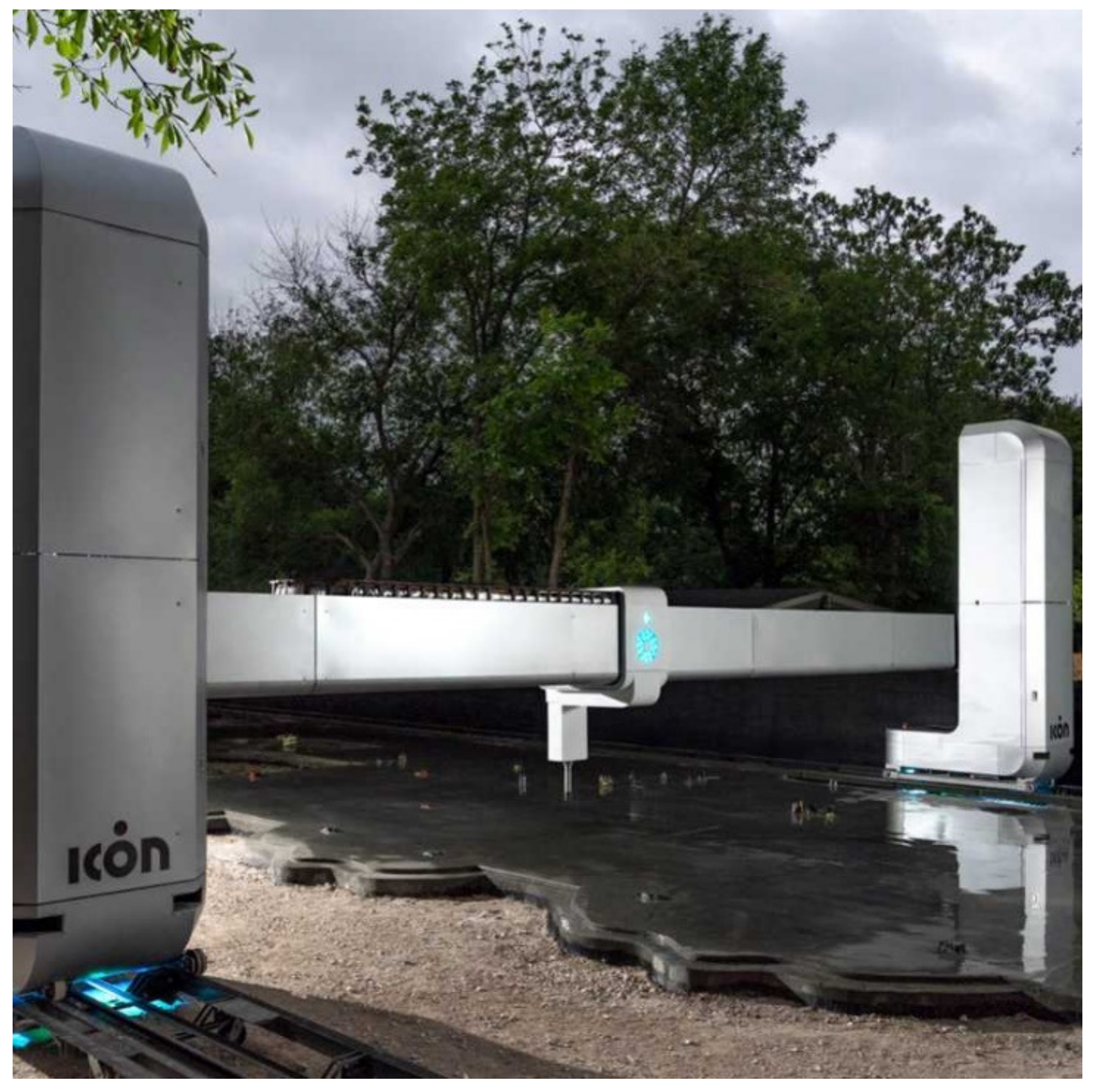Comparative Review of the Technology and Case Studies of 3D Concrete Printing of Buildings by Several Companies
Abstract
1. Introduction
1.1. Introduction and Background to the Industry
1.2. Literature Review of Issues and Future Endeavors of the Industry
2. Materials and Methods
2.1. Capabilities and Attributes of Gantry System Printers Used by Different Companies
2.1.1. ICON
2.1.2. COBOD
2.1.3. Black Buffalo
2.1.4. WinSun
2.1.5. WASP
2.1.6. SQ4D
2.1.7. Huashang Tengda
2.2. Capabilities and Attributes of Robotic Arm Printers Used by Selected Companies
2.2.1. Apis Cor
2.2.2. CyBe
2.3. Comparative Evaluation of the 3D Printing Systems and Printed Walls
2.4. Other Attributes of Gantry Frame Printers
2.5. Other Attributes of Robotic Arm Printers
2.6. Challenges Associate with the Current State of Practice
2.7. Approximate Thermal and Structural Evaluation
3. Concluding Remarks
4. Discussion
Author Contributions
Funding
Data Availability Statement
Conflicts of Interest
Appendix A
| ICON | |||||||
|---|---|---|---|---|---|---|---|
| Drawing Mimicking Printed Shape [20] | |||||||
 | |||||||
| Approximated Shape | |||||||
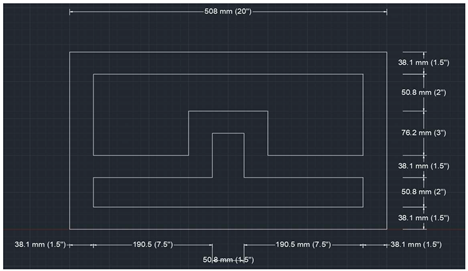 | |||||||
| Centroid Calculation | |||||||
| Shape | x [mm (in.)] | y [mm (in.)] | A [mm^2 (in.^2)] | xA [mm^3 (in.^3)] | yA [mm^3 (in.^3)] | ||
| 1.00 | 254.00 | 488.95 | 19,354.80 | 4,916,119.20 | 9,463,529.46 | ||
| 2.00 | 254.00 | 19.05 | 19,354.80 | 4,916,119.20 | 368,708.94 | ||
| 3.00 | 19.05 | 152.40 | 8709.66 | 165,919.02 | 1,327,352.18 | ||
| 4.00 | 488.95 | 152.40 | 8709.66 | 4,258,588.26 | 1,327,352.18 | ||
| 5.00 | 133.35 | 107.95 | 7258.05 | 967,860.97 | 783,506.50 | ||
| 6.00 | 374.65 | 107.95 | 7258.05 | 2,719,228.43 | 783,506.50 | ||
| 7.00 | 209.55 | 146.05 | 1451.61 | 304,184.88 | 212,007.64 | ||
| 8.00 | 298.45 | 146.05 | 1451.61 | 433,233.00 | 212,007.64 | ||
| 9.00 | 254.00 | 184.15 | 4838.70 | 1,229,029.80 | 891,046.61 | ||
| Sum | 78,386.9 | 19,910,282.8 | 15,369,017.6 | ||||
| Centroid (x) [mm (in)] | 254 (10) | ||||||
| Centroid (y) [mm (in)] | 196.07 (7.72) | ||||||
| Moment of Inertia/Stress Calculation | |||||||
| Shape | Area [mm^2 (in.^2)] | dx [mm (in.)] | dy [mm (in.)] | Adx^2 [mm^4 (in.^4)] | Ady^2 [mm^4 (in.^4)] | Ix [mm^4 (in.^4)] | Iy [mm^4 (in.^4)] |
| 1.00 | 19,354.80 | 89.66 | 0.00 | 155,598,545.14 | 0.00 | 2,341,301.77 | 416,231,425.60 |
| 2.00 | 19,354.80 | 177.04 | 0.00 | 606,626,917.92 | 0.00 | 2,341,301.77 | 416,231,425.60 |
| 3.00 | 8709.66 | 43.69 | 234.95 | 16,623,617.17 | 0.00 | 37,929,088.66 | 1,053,585.80 |
| 4.00 | 8709.66 | 43.69 | 234.95 | 16,623,617.17 | 0.00 | 37,929,088.66 | 1,053,585.80 |
| 5.00 | 7258.05 | 88.14 | 120.65 | 56,382,750.53 | 0.00 | 702,390.53 | 11,238,248.49 |
| 6.00 | 7258.05 | 88.14 | 120.65 | 56,382,750.53 | 0.00 | 702,390.53 | 11,238,248.49 |
| 7.00 | 1451.61 | 50.04 | 44.45 | 3,634,543.21 | 0.00 | 175,597.63 | 175,597.63 |
| 8.00 | 1451.61 | 50.04 | 44.45 | 3,634,543.21 | 0.00 | 175,597.63 | 175,597.63 |
| 9.00 | 4838.70 | 11.94 | 0.00 | 689,591.41 | 0.00 | 585,325.44 | 6,503,616.03 |
| Sum | 916,196,959.6 | 0.0 | 82,882,082.6 | 863,901,227.0 | |||
| Ix [mm^4 (in.^4)] | 9,990,000,000 (2400.3) | x [mm (in.)] | 254 (10) | ||||
| Iy [mm^4 (in.^4)] | 864,000,000 (2075.5) | y [mm (in.)] | 196.088 (7.72) | ||||
| σ [MPa (ksi)] | 0.000000196M (0.0032M) | ||||||
| PERI/COBOD | |||||||
| Drawing Mimicking Printed Shape [25] | |||||||
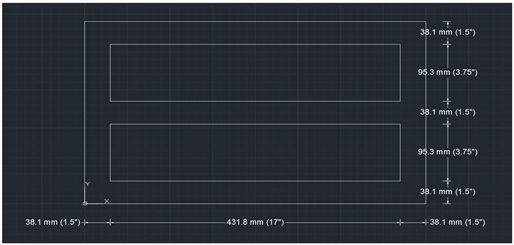 | |||||||
| Approximated Shape | |||||||
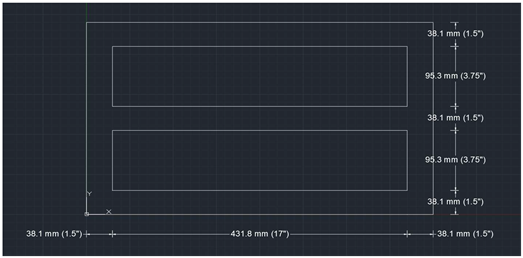 | |||||||
| Moment of Inertia/Stress Calculation | |||||||
| Shape | Area [mm^2 (in.^2)] | dx [mm (in.)] | dy [mm (in.)] | Adx^2 [mm^4 (in.^4)] | Ady^2 [mm^4 (in.^4)] | Ix [mm^4 (in.^4)] | Iy [mm^4 (in.^4)] |
| 1.00 | 154,838.40 | 0.00 | 0.00 | 0.00 | 0.00 | 1,198,746,505.73 | 3,329,851,404.80 |
| 2.00 | −82,257.90 | 66.68 | 0.00 | −365,682,070.05 | 0.00 | −62,190,802.22 | −1,278,092,702.39 |
| Sum | −365,682,070.05 | 0.00 | 1,136,555,703.50 | 2,051,760,783.57 | |||
| Ix [mm^4 (in.^4)] | 770,000,000 (1852) | x [mm (in.)] | 254 (10) | ||||
| Iy [mm^4 (in.^4)] | 2,100,000,000 (4929.4) | y [mm (in.)] | 152.4 (6) | ||||
| σ [MPa (ksi)] | 0.000000198M (0.0032M) | ||||||
| Black Buffalo/WinSun | |||||||
| Drawing Mimicking Printed Shape [28,31] | |||||||
 | |||||||
| Approximated Shape | |||||||
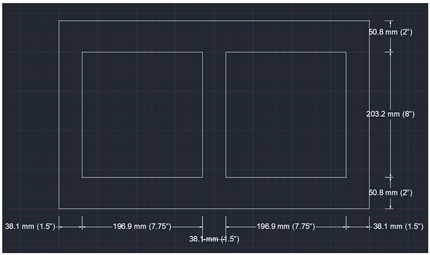 | |||||||
| Moment of Inertia/Stress Calculation | |||||||
| Shape | Area [mm^2 (in.^2)] | dx [mm (in.)] | dy [mm (in.)] | Adx^2 [mm^4 (in.^4)] | Ady^2 [mm^4 (in.^4)] | Ix [mm^4 (in.^4)] | Iy [mm^4 (in.^4)] |
| 1.00 | 154,838.40 | 0.00 | 0.00 | 0.00 | 0.00 | 1,198,746,505.73 | 3,329,851,404.80 |
| 2.00 | −79,999.84 | 0.00 | 117.48 | 0.00 | −1,104,028,882.52 | −275,267,577.39 | −258,332,369.37 |
| Sum | −1,104,028,882.52 | 923,478,928.34 | 3,071,519,035.43 | ||||
| Ix [mm^4 (in.^4)] | 924,000,000 (2218.7) | x [mm (in.)] | 254 (10) | ||||
| Iy [mm^4 (in.^4)] | 1,970,000,000 (4727) | y [mm (in.)] | 152.4 (6) | ||||
| σ [MPa (ksi)] | 0.000000165M (0.0027M) | ||||||
| WASP | |||||||
| Drawing Mimicking Printed Shape [33] | |||||||
 | |||||||
| Approximated Shape | |||||||
 | |||||||
| Moment of Inertia/Stress Calculation | |||||||
| Shape | Area [mm^2 (in.^2)] | dx [mm (in.)] | dy [mm (in.)] | Adx^2 [mm^4 (in.^4)] | Ady^2 [mm^4 (in.^4)] | Ix [mm^4 (in.^4)] | Iy [mm^4 (in.^4)] |
| 1.00 | 19,354.80 | 133.35 | 0.00 | 344,171,360.04 | 0.00 | 2,341,301.77 | 416,231,425.60 |
| 2.00 | 8709.66 | 0.00 | 234.95 | 0.00 | 480,788,919.71 | 37,929,088.66 | 1,053,065.51 |
| 3.00 | 8709.66 | 0.00 | 234.95 | 0.00 | 480,788,919.71 | 37,929,088.66 | 1,053,065.51 |
| 4.00 | 8709.66 | 0.00 | 78.32 | 0.00 | 53,419,557.39 | 37,929,088.66 | 1,053,065.51 |
| 5.00 | 8709.66 | 0.00 | 78.32 | 0.00 | 53,419,557.39 | 37,929,088.66 | 1,053,065.51 |
| 688,363,531.66 | 1,068,424,446.37 | 156,398,958.17 | 836,677,194.38 | ||||
| Ix [mm^4 (in.^4)] | 845,000,000 (2029.5) | x [mm (in.)] | 254 (10) | ||||
| Iy [mm^4 (in.^4)] | 1,910,000,000 (5722) | y [mm (in.)] | 152.4 (6) | ||||
| σ [MPa (ksi)] | 0.00000018M (0.003M) | ||||||
| SQ4D/CyBe | |||||||
| Drawing Mimicking Printed Shape [8,50] | |||||||
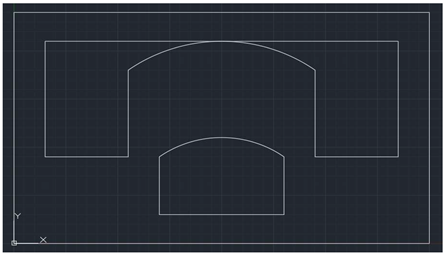 | |||||||
| Approximated Shape | |||||||
 | |||||||
| Centroid Calculation | |||||||
| Shape | x [mm (in.)] | y [mm (in.)] | A [mm^2 (in.^2)] | xA [mm^3 (in.^3)] | yA [mm^3 (in.^3)] | ||
| 1.00 | 254.00 | 19.05 | 19,354.80 | 4,916,119.20 | 368,708.94 | ||
| 2.00 | 254.00 | 285.75 | 19,354.80 | 4,916,119.20 | 5,530,634.10 | ||
| 3.00 | 19.05 | 152.40 | 8709.66 | 165,919.02 | 1,327,352.18 | ||
| 4.00 | 488.95 | 152.40 | 8709.66 | 4,258,588.26 | 1,327,352.18 | ||
| 5.00 | 127.00 | 76.20 | 13,548.36 | 1,720,641.72 | 1,032,385.03 | ||
| 6.00 | 381.00 | 76.20 | 13,548.36 | 5,161,925.16 | 1,032,385.03 | ||
| 7.00 | 254.00 | 190.50 | 34,838.64 | 8,849,014.56 | 6,636,760.92 | ||
| Sum | 0.00 | 0.00 | 118,064.28 | 29,988,327.12 | 17,255,578.39 | ||
| Centroid (x) [mm (in.)] | 254.00 | ||||||
| Centroid (y) [mm (in.)] | 146.15 | ||||||
| Moment of Inertia/Stress Calculation | |||||||
| Shape | Area [mm^2 (in.^2)] | dx [mm (in.)] | dy [mm (in.)] | Adx^2 [mm^4 (in.^4)] | Ady^2 [mm^4 (in.^4)] | Ix [mm^4 (in.^4)] | Iy [mm^4 (in.^4)] |
| 1.00 | 19,354.80 | 127.10 | 0.00 | 312,685,538.89 | 0.00 | 2,341,301.77 | 416,231,425.60 |
| 2.00 | 19,354.80 | 88.80 | 0.00 | 152,607,026.70 | 0.00 | 2,341,301.77 | 416,231,425.60 |
| 3.00 | 8709.66 | 6.25 | 234.95 | 339,775.05 | 480,786,422.32 | 37,929,088.66 | 1,053,585.80 |
| 4.00 | 8709.66 | 6.25 | 234.95 | 339,775.05 | 480,786,422.32 | 37,929,088.66 | 1,053,585.80 |
| 5.00 | 13,548.36 | 69.95 | 127.00 | 66,299,927.68 | 218,521,498.44 | 6,555,644.95 | 35,691,844.75 |
| 6.00 | 13,548.36 | 69.95 | 127.00 | 66,299,927.68 | 218,521,498.44 | 6,555,644.95 | 35,691,844.75 |
| 7.00 | 34,838.64 | 44.35 | 0.00 | 68,512,240.79 | 0.00 | 67,429,490.95 | 151,716,354.63 |
| Sum | 667,084,211.99 | 1,398,615,841.52 | 161,081,561.71 | 1,057,670,275.03 | |||
| Ix [mm^4 (in.^4)] | 828,000,000 (1989.7) | x [mm (in.)] | 254 (10) | ||||
| Iy [mm^4 (in.^4)] | 2,460,000,000(5901.3) | y [mm (in.)] | 158.6 (6.25) | ||||
| σ [MPa (ksi)] | 0.000000192M (0.00314M) | ||||||
| Apis Cor | |||||||
| Drawing Mimicking Printed Shape [43] | |||||||
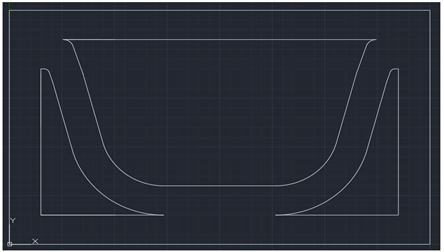 | |||||||
| Approximated Shape | |||||||
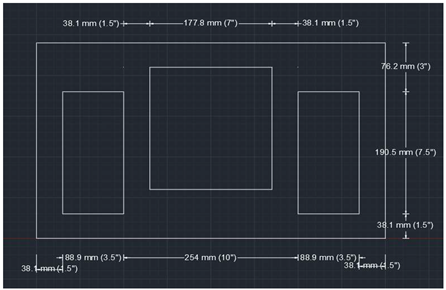 | |||||||
| Moment of Inertia/Stress Calculation | |||||||
| Shape | Area [mm^2 (in.^2)] | dx [mm (in.)] | dy [mm (in.)] | Adx^2 [mm^4 (in.^4)] | Ady^2 [mm^4 (in.^4)] | Ix [mm^4 (in.^4)] | Iy [mm^4 (in.^4)] |
| 1.00 | 19,354.80 | 133.35 | 0.00 | 344,171,360.04 | 0.00 | 2,341,301.77 | 416,231,425.60 |
| 2.00 | 19,354.80 | 133.35 | 0.00 | 344,171,360.04 | 0.00 | 2,341,301.77 | 416,231,425.60 |
| 3.00 | 8709.66 | 0.00 | 234.95 | 0.00 | 480,786,422.32 | 37,929,088.66 | 1,053,585.80 |
| 4.00 | 8709.66 | 0.00 | 234.95 | 0.00 | 480,786,422.32 | 37,929,088.66 | 1,053,585.80 |
| 5.00 | 4838.70 | 95.25 | 152.40 | 43,899,428.98 | 112,382,484.91 | 585,325.44 | 6,503,616.03 |
| 6.00 | 4838.70 | 95.25 | 152.40 | 43,899,428.98 | 112,382,484.91 | 585,325.44 | 6,503,616.03 |
| 7.00 | 5806.44 | 0.00 | 107.95 | 0.00 | 67,663,621.12 | 11,238,248.49 | 702,390.53 |
| 8.00 | 5806.44 | 0.00 | 107.95 | 0.00 | 67,663,621.12 | 11,238,248.49 | 702,390.53 |
| 9.00 | 9677.40 | 95.25 | 0.00 | 87,798,816.34 | 0.00 | 1,170,650.88 | 52,028,928.20 |
| Sum | 0.00 | 0.00 | 0.00 | 863,940,352.76 | 1,321,665,056.72 | 105,358,579.61 | 901,011,172.22 |
| Ix [mm^4 (in.^4)] | 969,000,000 (2328.75) | x [mm (in.)] | 254 (10) | ||||
| Iy [mm^4 (in.^4)] | 2,220,000,000 (5340) | y [mm (in.)] | 152.4 (6) | ||||
| σ [MPa (ksi)] | 0.000000157M (0.0026M) | ||||||
References
- Rogers, J. Construction Needs 650k New Workers to Meet Housing Demand. GlobeSt. 2022. Available online: https://www.globest.com/2022/03/02/construction-needs-650k-new-workers-to-meet-housing-demand/?slreturn=20220228214502 (accessed on 2 December 2022).
- Elfatah, A.S.A. 3D Printing in Architecture, Engineering and Construction. Eng. Res. J. 2019, 162, 119–137. [Google Scholar] [CrossRef]
- ICON. Projects. ICON. 2022. Available online: https://www.iconbuild.com/projects (accessed on 28 March 2022).
- Black Buffalo 3D. Products & Services; Black Buffalo 3D: East Stroudsburg, PA, USA, 2022; Available online: https://bb3d.io/products-services/#specs (accessed on 30 March 2022).
- Zainab, O. Exploring the Potential of 3D Printing for Building Houses in Nigeria and Brief Numerical Analysis of Lintels in 3D Printed Houses. Master’s Thesis, Graduate School of Science and Engineering Ritsumeikan University, Kyoto, Japan, 2020. [Google Scholar]
- Pimpley, P. Success Factors for 3D Printing Technology Adoption in Construction. Ph.D. Thesis, University of Maryland, College Park, MD, USA, 2019. [Google Scholar]
- SQ4D. Frequently Asked Questions: Sq4d Inc. SQ4D. 2022. Available online: https://www.sq4d.com/faqs/ (accessed on 12 April 2022).
- SQ4D. 3D Printed Houses by SQ4D. 2022. Available online: https://www.sq4d.com/ (accessed on 12 April 2022).
- COBOD. Contact US—for More Information about Modular Construction Printers. COBOD. 2022. Available online: https://cobod.com/contact/ (accessed on 30 March 2022).
- WASP. The First 3D Printed House with Earth: Gaia. 3D Printers WASP, WASP. 2022. Available online: https://www.3dwasp.com/en/3d-printed-house-gaia/ (accessed on 12 April 2022).
- Hager, I.; Golonka, A.; Putanowicz, R. 3D printing of buildings and building components as the future of sustainable construction? Procedia Eng. 2016, 151, 292–299. [Google Scholar] [CrossRef]
- Sanjayan, J.G.; Nematollahi, B. 3D concrete printing for construction applications. In 3D Concrete Printing Technology; Butterworth-Heinemann: Oxford, UK, 2019; pp. 1–11. [Google Scholar]
- Baghalzadeh Shishehgarkhaneh, M.; Keivani, A.; Moehler, R.C.; Jelodari, N.; Roshdi Laleh, S. Internet of things (IOT), building information modeling (BIM), and digital twin (DT) in construction industry: A review, Bibliometric, and network analysis. Buildings 2022, 12, 1503. [Google Scholar] [CrossRef]
- Tay, Y.W.; Panda, B.; Paul, S.C.; Noor Mohamed, N.A.; Tan, M.J.; Leong, K.F. 3D printing trends in building and Construction Industry: A Review. Virtual Phys. Prototyp. 2017, 12, 261–276. [Google Scholar] [CrossRef]
- Buswell, R.A.; Leal de Silva, W.R.; Jones, S.Z.; Dirrenberger, J. 3D printing using concrete extrusion: A roadmap for Research. Cem. Concr. Res. 2018, 112, 37–49. [Google Scholar] [CrossRef]
- Valente, M.; Sibai, A.; Sambucci, M. Extrusion-based additive manufacturing of concrete products: Revolutionizing and remodeling the construction industry. J. Compos. Sci. 2019, 3, 88. [Google Scholar] [CrossRef]
- Freire, T.; Brun, F.; Mateus, A.; Gaspar, F. 3D printing technology in the construction industry. In Sustainability and Automation in Smart Constructions; Springer: Cham, Switzerland, 2020; pp. 157–167. [Google Scholar]
- ICON. Vulcan. 2022. Available online: https://www.iconbuild.com/vulcan (accessed on 30 March 2022).
- ICON. Home. 2022. Available online: https://www.iconbuild.com/ (accessed on 30 March 2022).
- Risinger, M. Is This the Future of Construction? 3D Concrete Printed Homes. YouTube. 2021. Available online: https://www.youtube.com/watch?v=_MsOXrprYXs (accessed on 30 March 2022).
- Sertoglu, K.; Hanaphy, P.; Everett, H. Icon To Build Largest Ever Neighborhood of 3D Printed Homes in Austin. 3D Printing Industry. 2021. Available online: https://3dprintingindustry.com/news/icon-to-build-largest-ever-neighborhood-of-3d-printed-homes-in-austin-198432/ (accessed on 30 March 2022).
- ICON. New Story and Icon Unveil the First Permitted 3D-Printed Home. 2018. Available online: https://www.iconbuild.com/updates/new-story-and-icon-unveil-the-first-permitted-3d-printed-home (accessed on 30 March 2022).
- COBOD. Bod2—Modular 3D Construction Printer Available Now. 2022. Available online: https://cobod.com/bod2/ (accessed on 30 March 2022).
- COBOD. BOD2. 2020. Available online: https://cobod.com/wp-content/uploads/2020/09/BOD2-Specifications-1.pdf (accessed on 30 March 2022).
- Gross, J. The Most Innovative 3D Printed House in the...-Youtube. YouTube. 2021. Available online: https://www.youtube.com/watch?v=qWBA-6NgIJg (accessed on 30 March 2022).
- PERI. Printed Buildings: 360 Degree Tours. 3D, PERI. 2022. Available online: https://www.peri3dconstruction.com/360-tours (accessed on 30 March 2022).
- Gross, J. 5 Apartment Units 3D Printed On Site, World First! | Exclusive Early Interior Tour. YouTube. 2021. Available online: https://www.youtube.com/watch?v=Zisu_vIJ5Uw (accessed on 30 March 2022).
- Gross, J. Secrets of 3D Printed Concrete Exposed | Bold Black Buffalo 3D Shares All-Youtube.com. YouTube. 2021. Available online: https://www.youtube.com/watch?v=R7lAnIWy5lg (accessed on 30 March 2022).
- Holt, C.; Edwards, L.; Keyte, L.; Moghaddam, F.; Townsend, B. Construction 3D printing. In 3D Concrete Printing Technology; Butterworth-Heinemann: Oxford, UK, 2019; pp. 349–370. [Google Scholar]
- Massie, C. China’s Winsun Unveils Two New 3D Printed Buildings. Architect. 2015. Available online: https://www.architectmagazine.com/technology/chinas-winsun-unveils-two-new-3d-printed-buildings_o (accessed on 12 April 2022).
- WinSun. 3D Printing Architecture Profile. Product Center-Yingchuang Building Technique Shanghai co.ltd. (Winsun). Available online: http://www.winsun3d.com/En/Product/pro_inner/id/1 (accessed on 21 September 2022).
- WASP. Features. 3D Printers WASP. 2022. Available online: https://www.3dwasp.com/en/3d-printer-house-crane-wasp/ (accessed on 12 April 2022).
- Alhumayani, H.; Gomaa, M.; Soebarto, V.; Jabi, W. Environmental assessment of large-scale 3D printing in construction: A comparative study between COB and concrete. J. Clean. Prod. 2020, 270, 122463. [Google Scholar] [CrossRef]
- SQ4D. Recent Projects. 2022. Available online: https://www.sq4d.com/projects/ (accessed on 12 April 2022).
- Gross, J. SQ4D First MLS Sale 3D Printed House Finally under Construction in Long Island, NY. YouTube. 2021. Available online: https://www.youtube.com/watch?v=wj6qzfif6Gw&t=86s (accessed on 24 October 2022).
- SQ4D. Changing the Speed of Building. 2022. Available online: https://www.sq4d.com/speed/ (accessed on 12 April 2022).
- Essop, A. SQ4D 3d Prints 1900 sq ft Home in 48 Hours. 3D Printing Industry. 2020. Available online: https://3dprintingindustry.com/news/sq4d-3d-prints-1900-sq-ft-home-in-48-hours-167141/ (accessed on 12 April 2022).
- New China TV. World’s First 3D-Printed House That Can Withstand 8.0-Magnitude Quake. YouTube. 2016. Available online: https://www.youtube.com/watch?v=OloOc21_u80 (accessed on 14 April 2022).
- Craveiro, F.; Duarte, J.P.; Bartolo, H.; Bartolo, P.J. Additive Manufacturing as an enabling technology for Digital Construction: A perspective on construction 4.0. Autom. Constr. 2019, 103, 251–267. [Google Scholar] [CrossRef]
- Gross, J. I Visited the Worlds Biggest 3D Printed Building!!!” YouTube. 2021. Available online: https://www.youtube.com/watch?v=ydlpQqwiy-M&t=332s (accessed on 24 October 2022).
- Apis Cor. Knowledge Hub. 2022. Available online: https://www.apis-cor.com/knowledge-base (accessed on 30 March 2022).
- Richard, N. Choosing Insulation for Masonry Cavity Walls. Building Enclosure RSS, Building Enclosure. 2018. Available online: https://www.buildingenclosureonline.com/articles/87471-choosing-insulation-for-masonry-cavity-walls (accessed on 30 March 2022).
- Apis Cor. 3D Houses. 2022. Available online: https://www.apis-cor.com/showroom (accessed on 30 March 2022).
- Pessoa, S.; Guimarães, A.S.; Lucas, S.S.; Simões, N. 3D printing in the construction industry—A systematic review of the thermal performance in buildings. Renew. Sustain. Energy Rev. 2021, 141, 110794. [Google Scholar] [CrossRef]
- CyBe. Our Story. CyBe Construction. 2022. Available online: https://cybe.eu/our-story/ (accessed on 30 March 2022).
- CyBe. 3D Concrete Printers. CyBe Construction. 2022. Available online: https://cybe.eu/technology/3d-printers/ (accessed on 30 March 2022).
- CyBe. We Redefine Construction. CyBe Construction. 2022. Available online: https://cybe.eu/ (accessed on 30 March 2022).
- Krimi, I.; Lafhaj, Z.; Ducoulombier, L. Prospective study on the integration of additive manufacturing to building industry—case of a French construction company. Addit. Manuf. 2017, 16, 107–114. [Google Scholar] [CrossRef]
- CyBe. CyBe 3Dcp Specifications. CyBe. 2021. Available online: https://lybrary.cybe.eu/wp-content/uploads/dlm_uploads/2021/07/3D-specifications-V3.6-NC.pdf (accessed on 30 March 2022).
- CyBe. R&DRone Laboratory. CyBe Construction. 2022. Available online: https://cybe.eu/cases/rdrone-lab/ (accessed on 30 March 2022).
- 3D Construction Printing. Exclusive Winsun 3D Concrete Printing Factory Tour, Suzhou China. YouTube. 2019. Available online: https://www.youtube.com/watch?v=ZUdrorzKrrc (accessed on 12 April 2022).
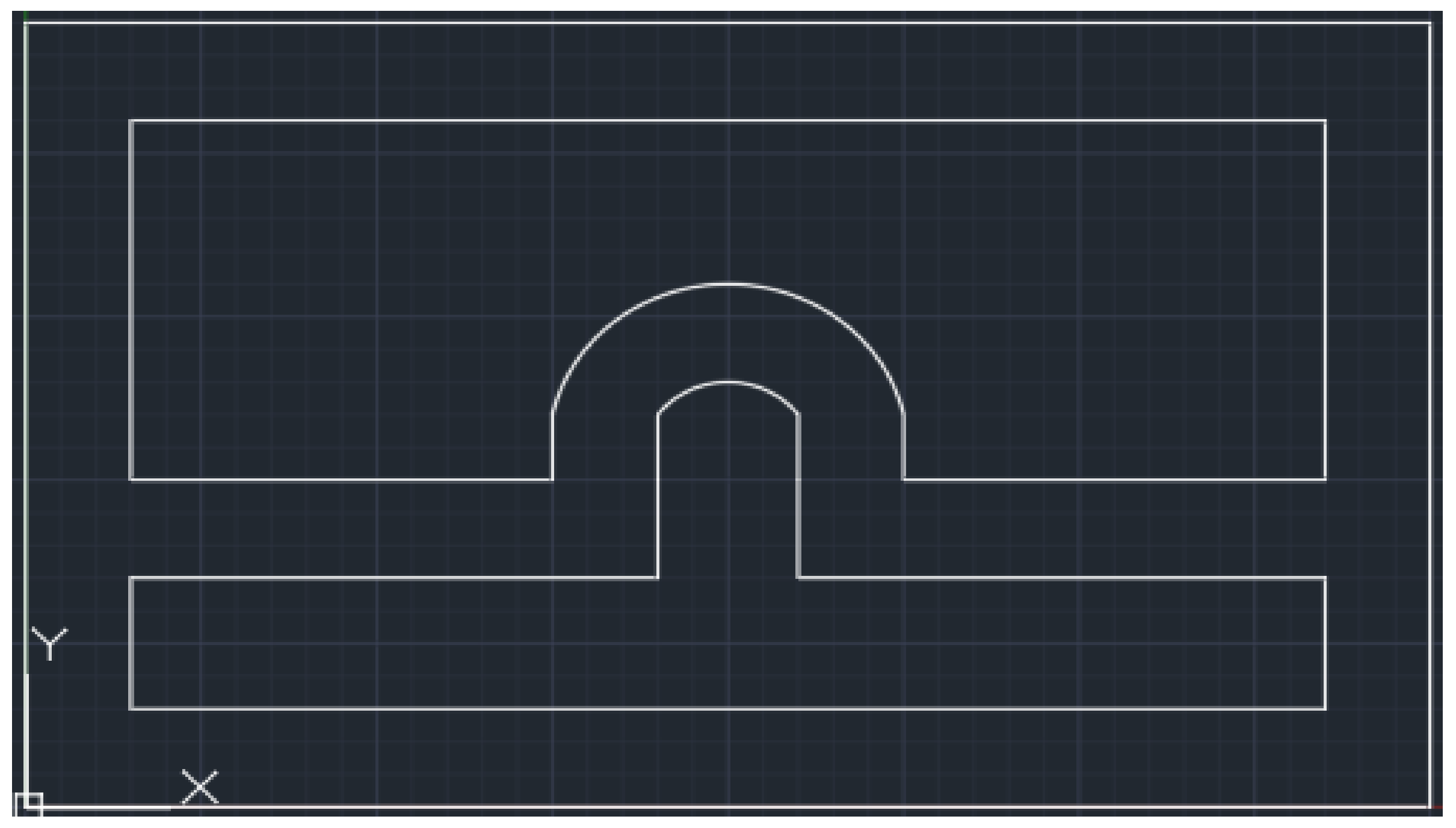
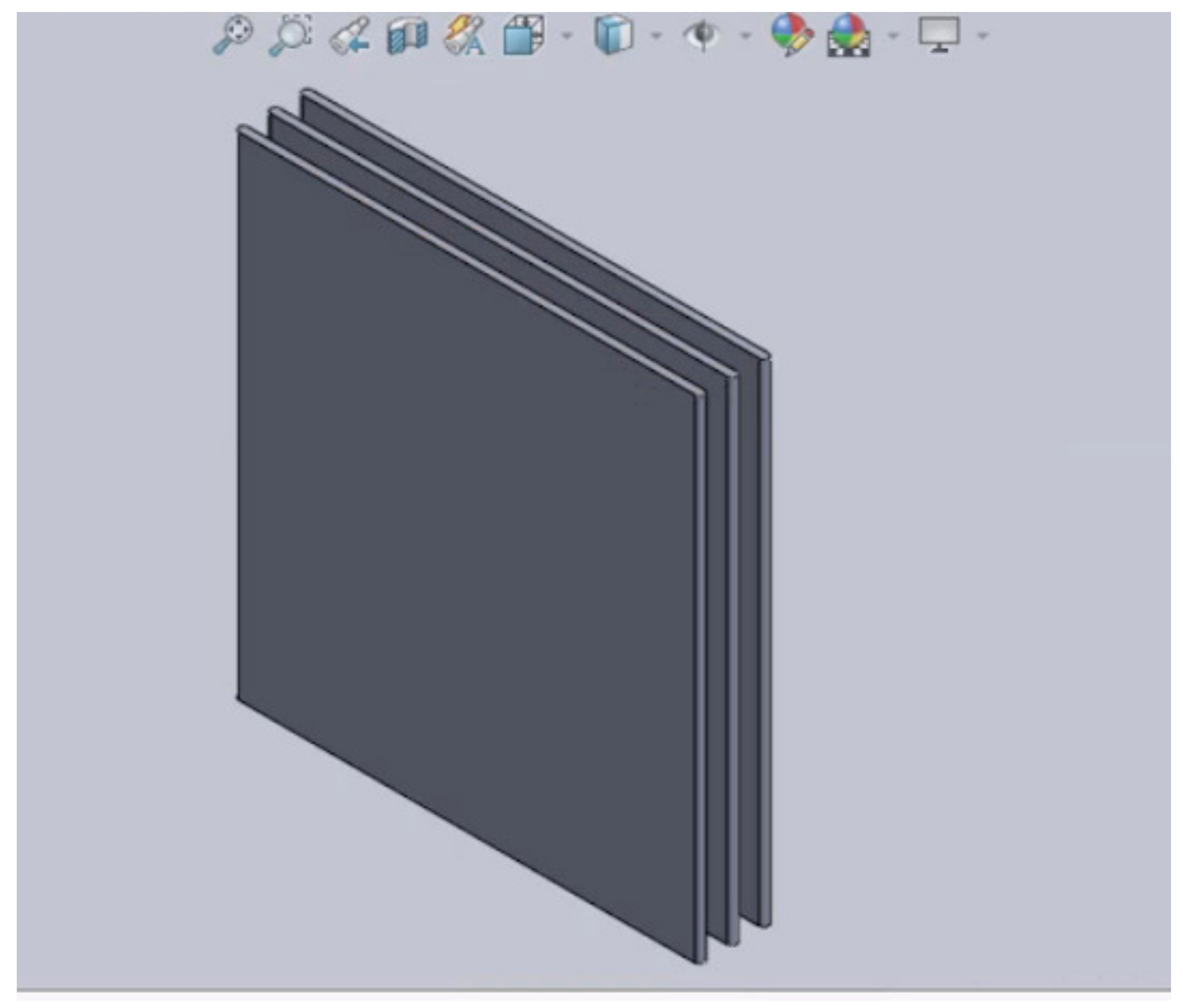
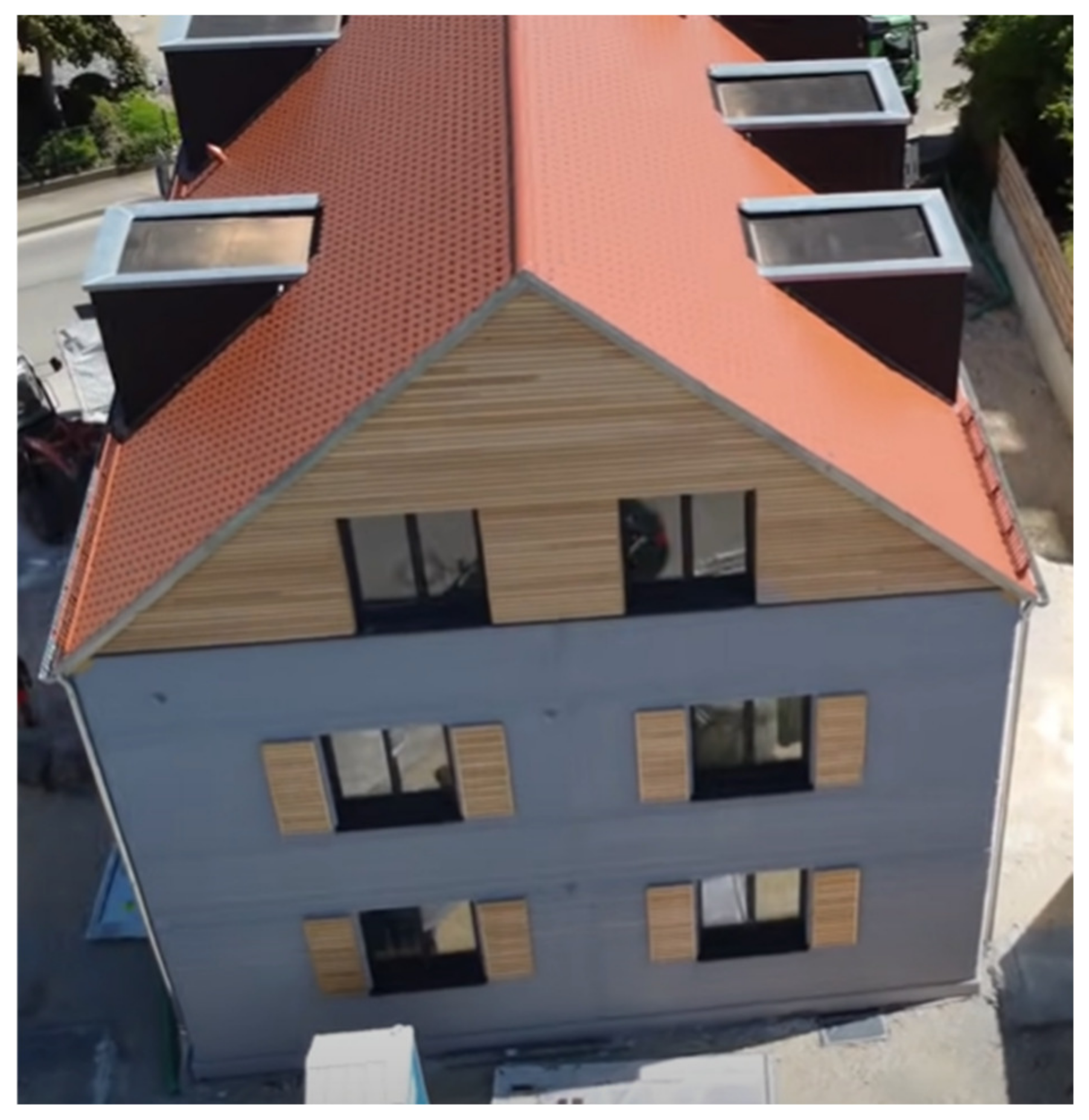
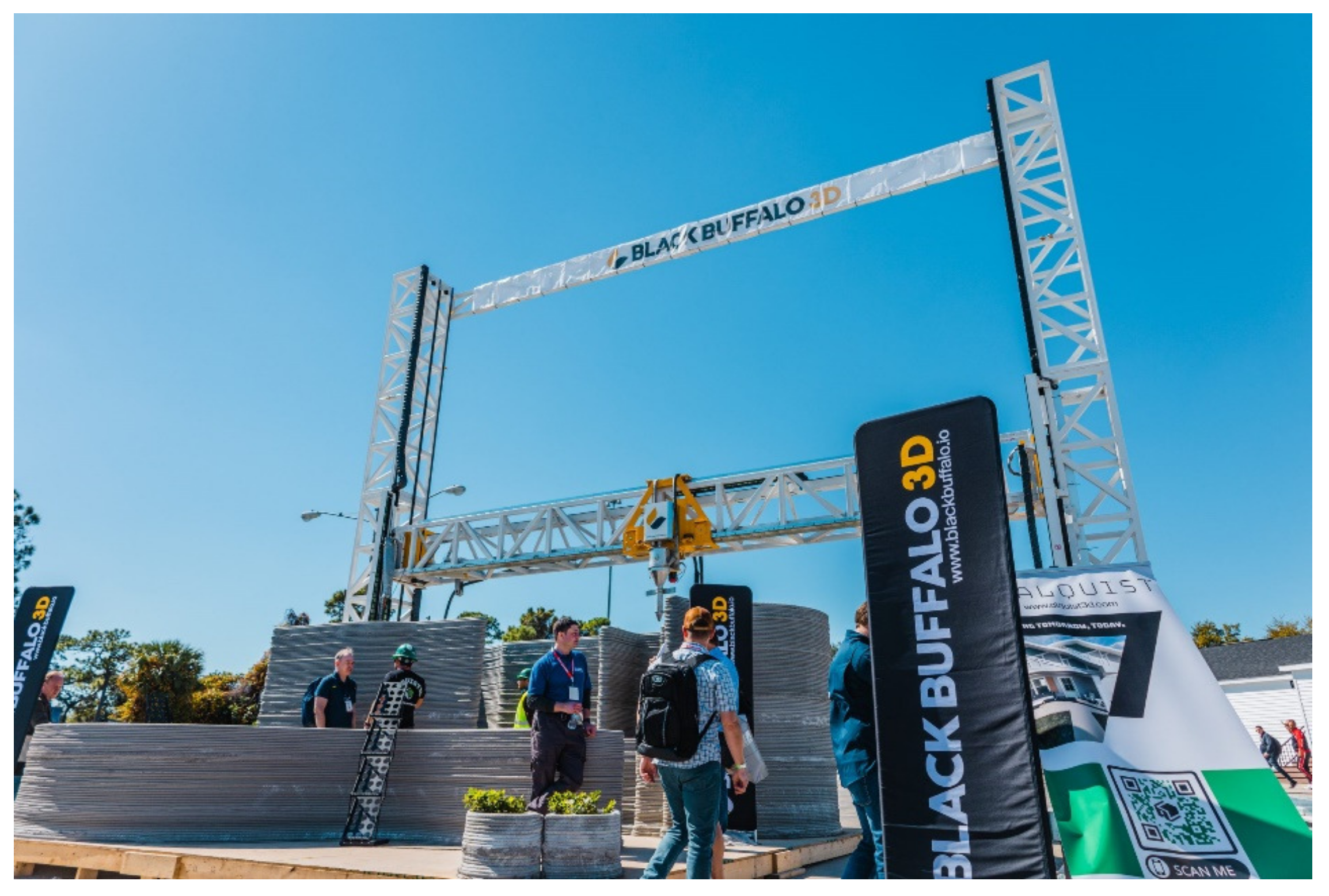
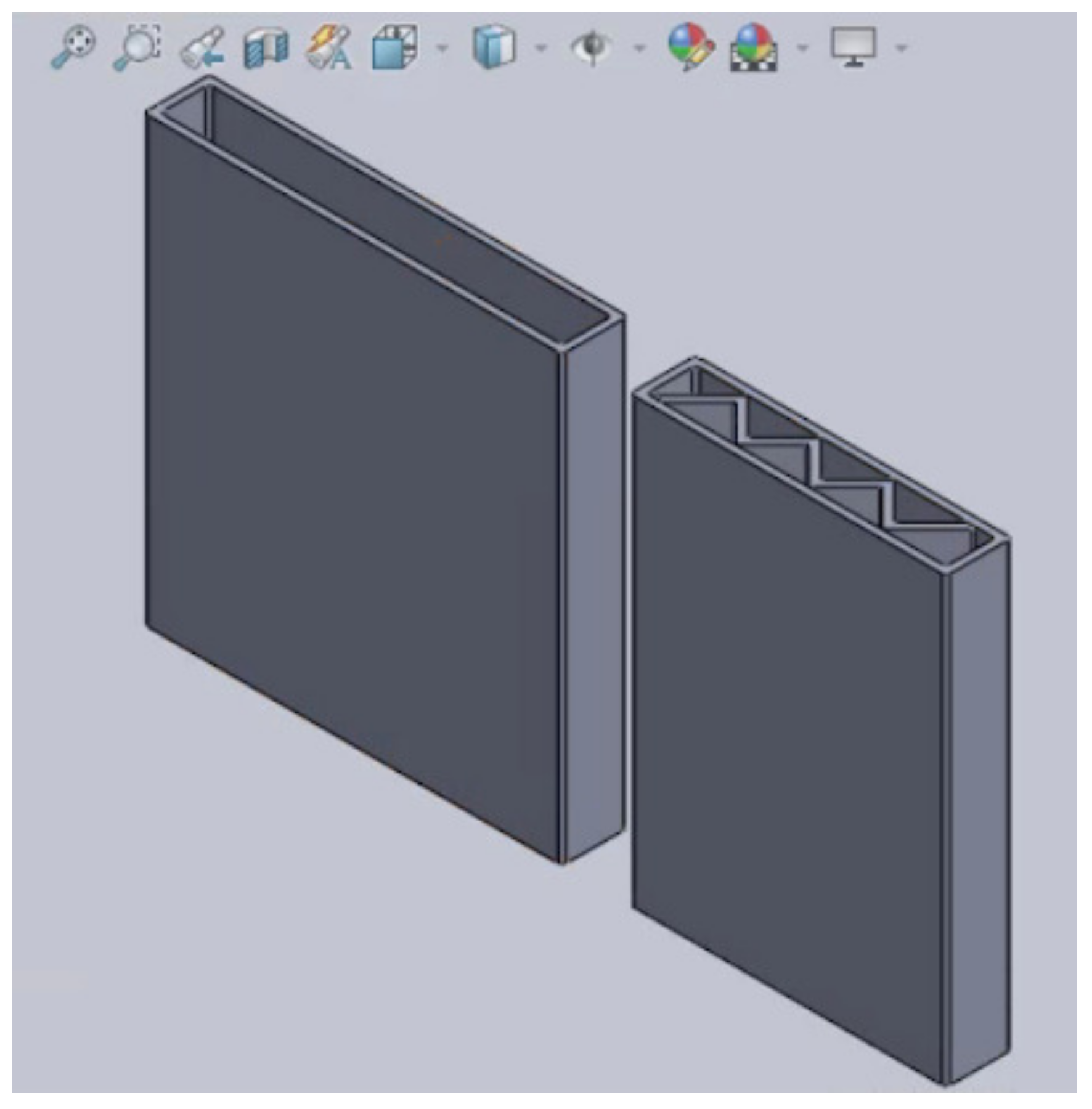
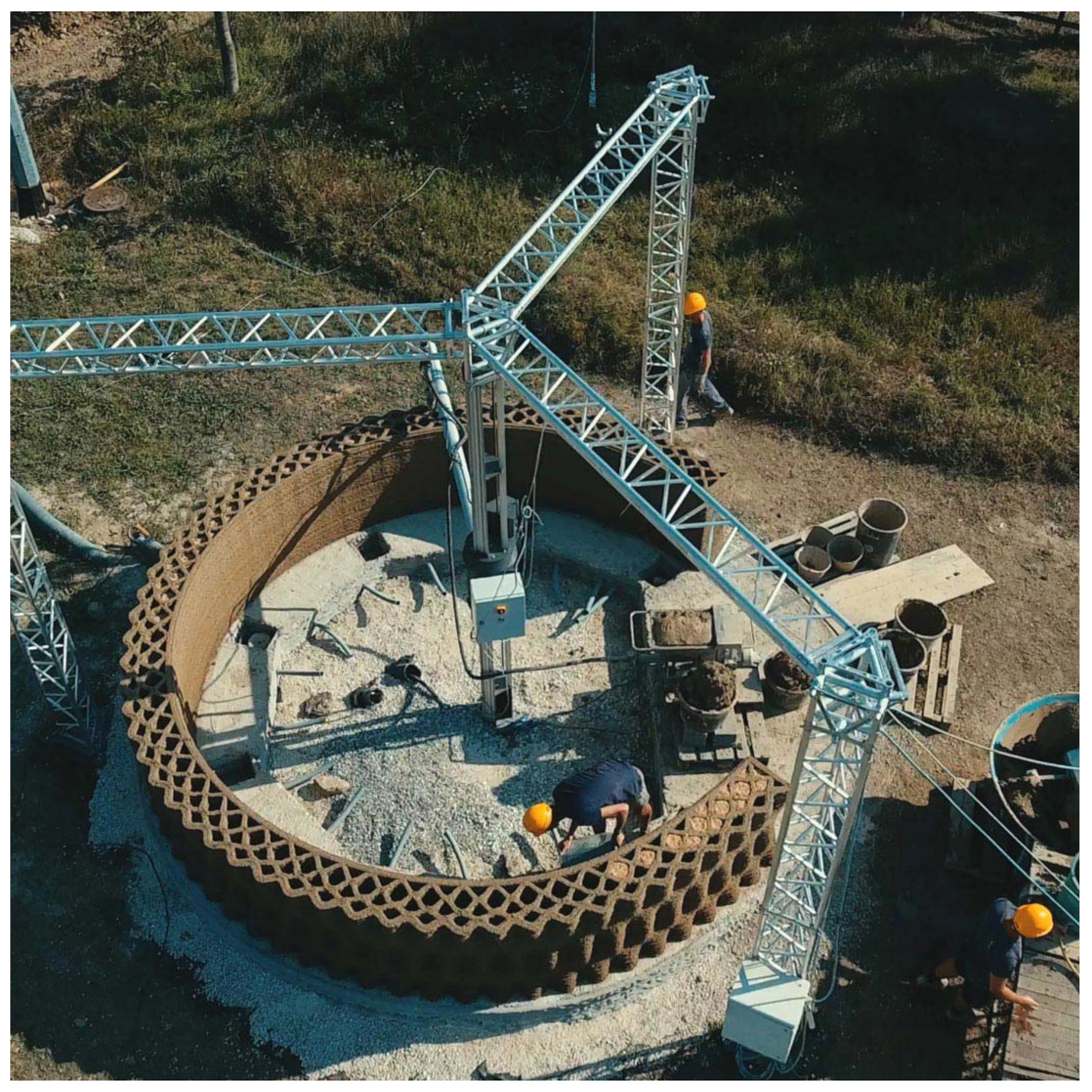
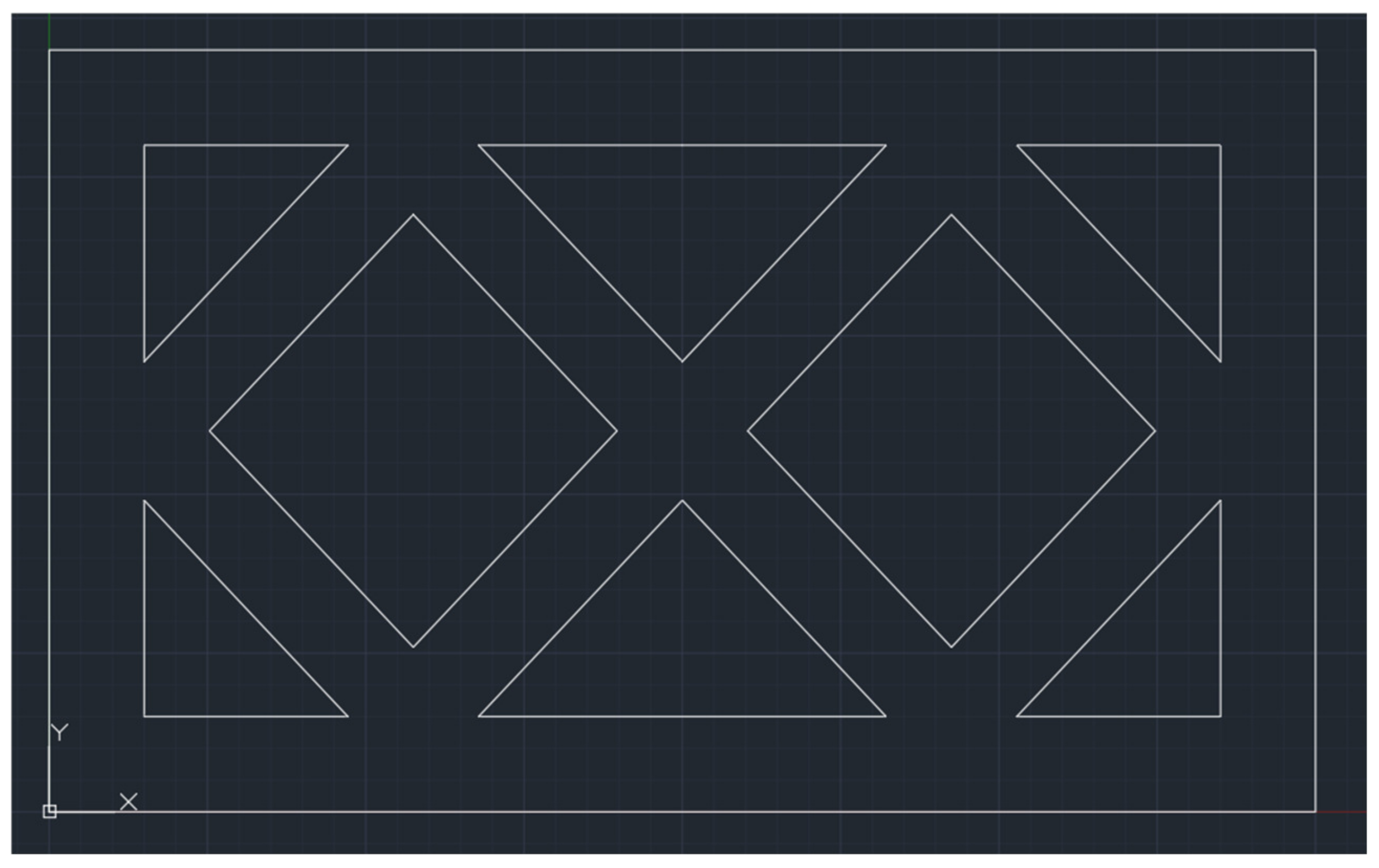


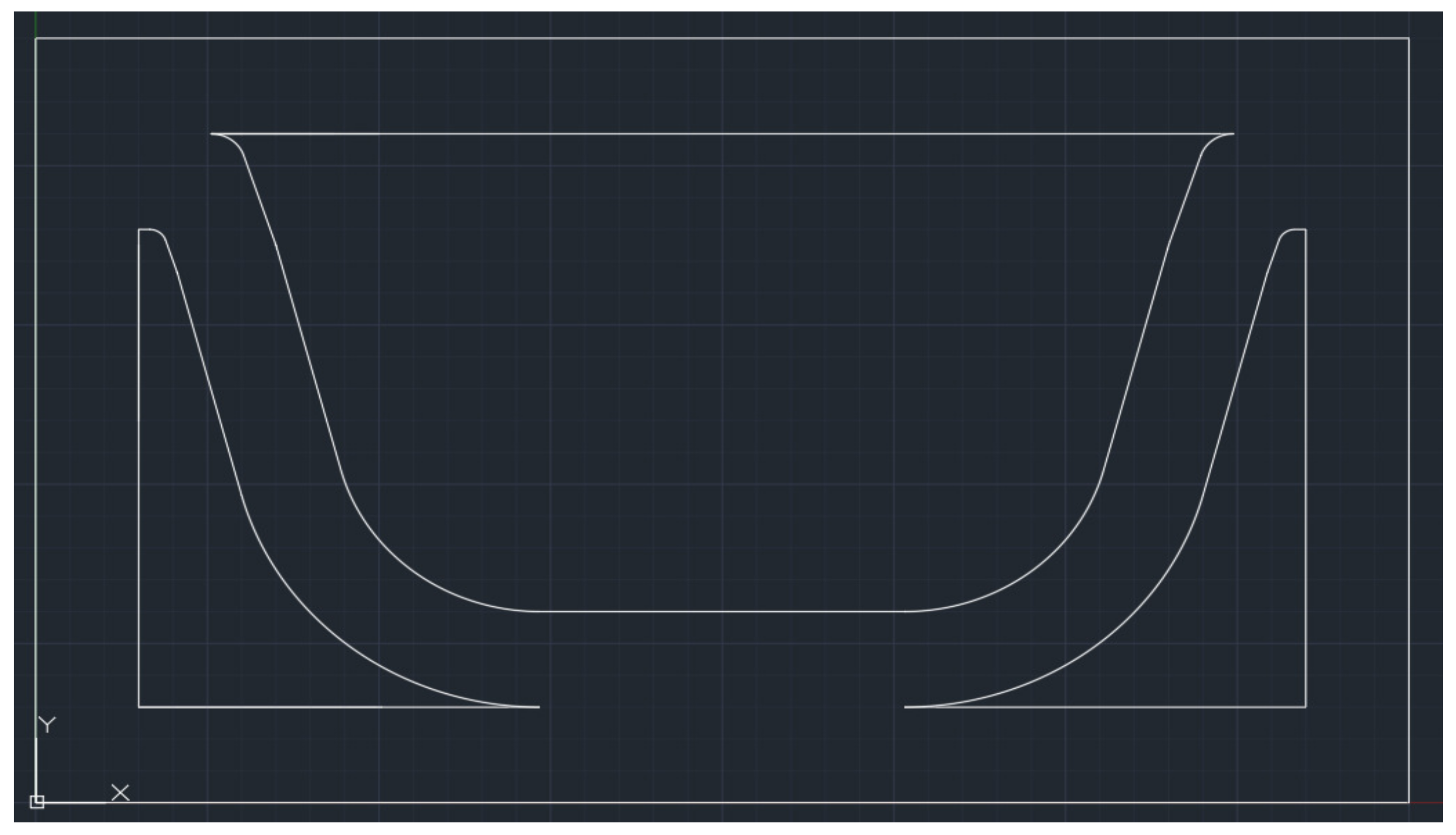
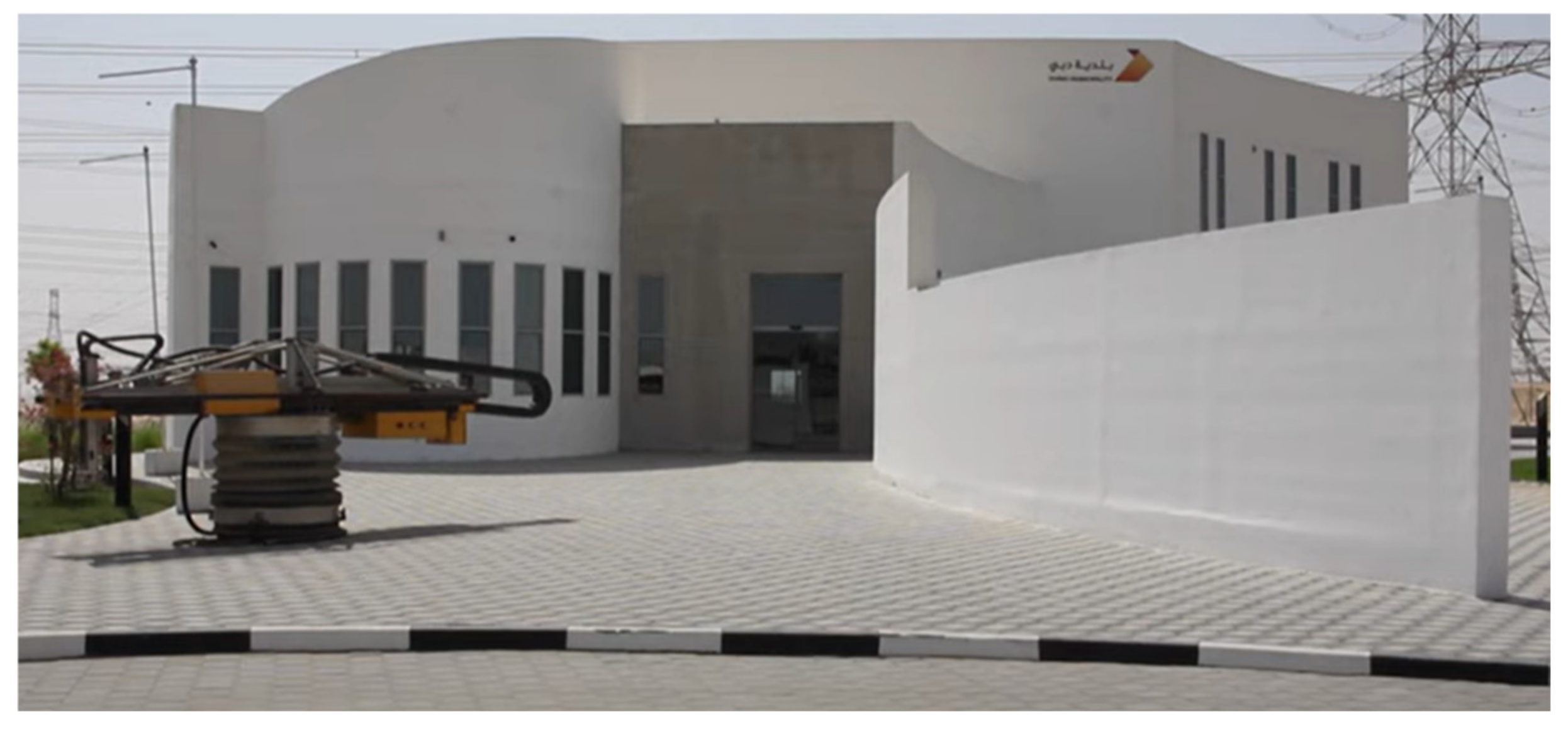
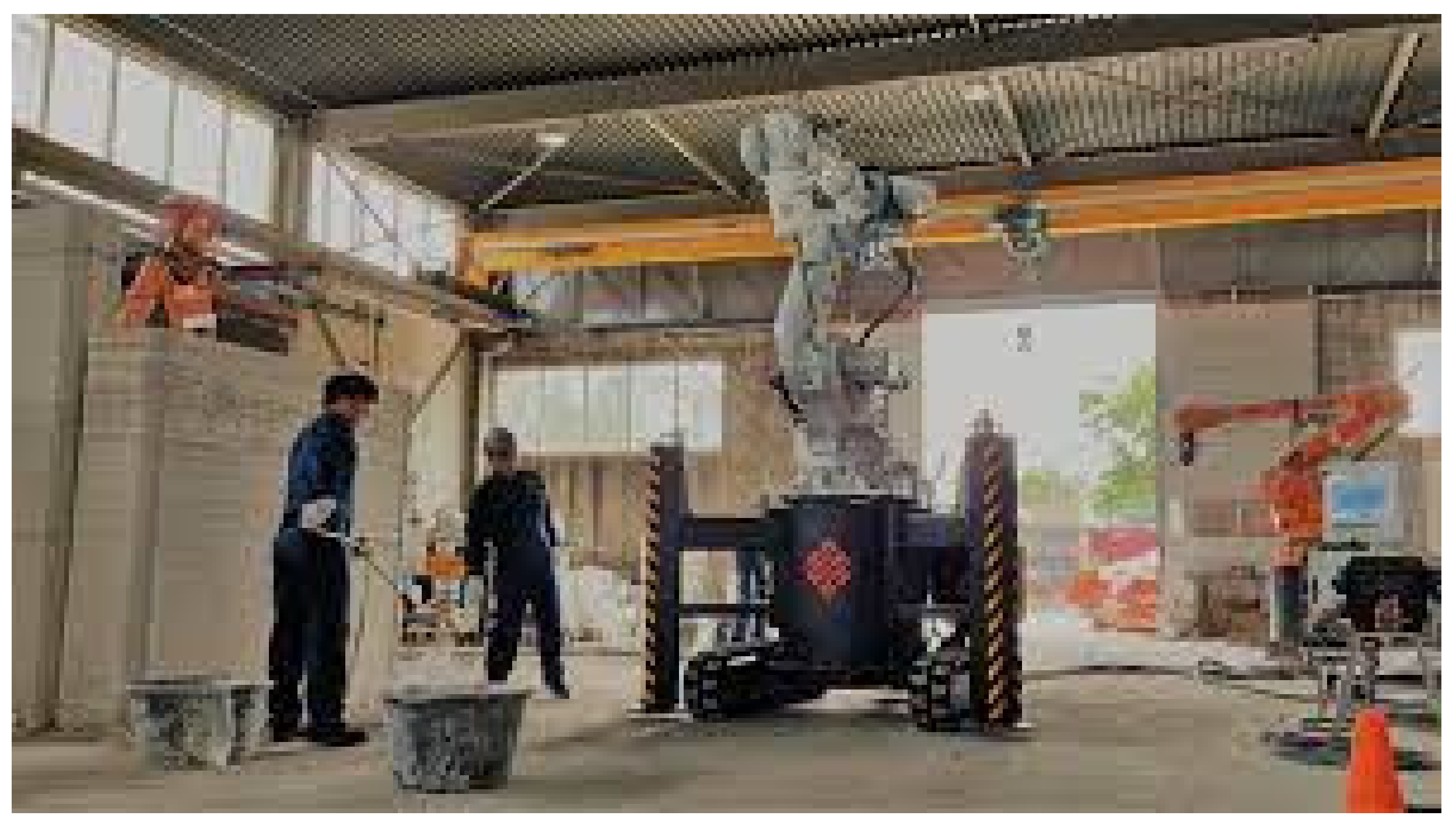
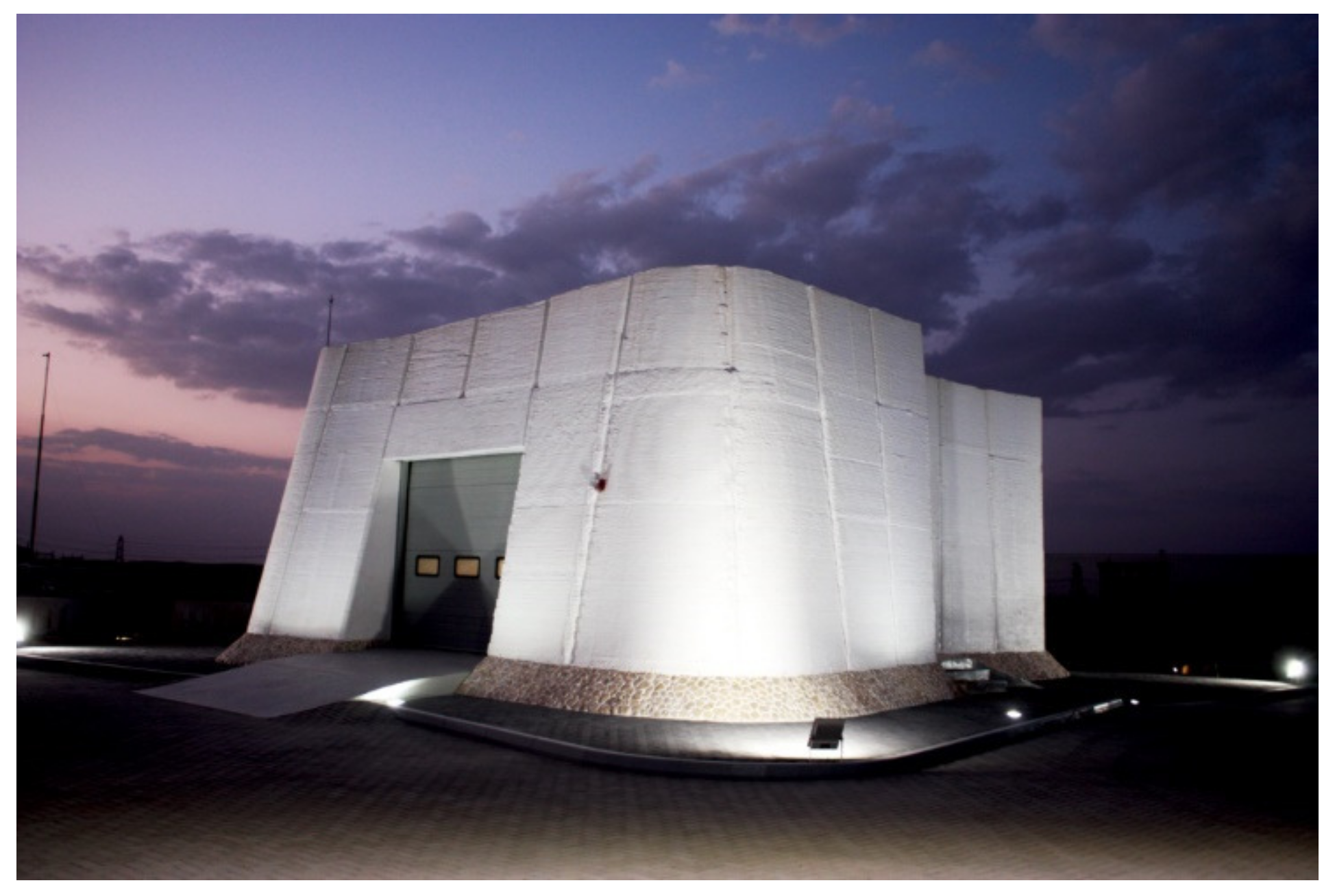
| Material | Quantity (kg (lb)) | Price (USD) | Percentages by Weight |
|---|---|---|---|
| Cement | 6100 (13,448) | 1515.45 | 32% |
| 0–2 mm (dia.) sand | 3500 (7716) | 87.16 | 18% |
| 0–4 mm (dia.) gravel | 3500 (7716) | 92.60 | 18% |
| 0–4 mm (side dimension) recycled roof tiles | 4400 (9700) | 76.26 | 23% |
| Water | 1700 (3748) | 8.72 | 9% |
| Glonium sky 631 | 40 (88) | 28.33 | ~0% |
| Crackstop fibers | 20 (44) | 151.44 | ~0% |
| Total | 19,260 (42,460) | 1959.96 | 100% |
Disclaimer/Publisher’s Note: The statements, opinions and data contained in all publications are solely those of the individual author(s) and contributor(s) and not of MDPI and/or the editor(s). MDPI and/or the editor(s) disclaim responsibility for any injury to people or property resulting from any ideas, methods, instructions or products referred to in the content. |
© 2022 by the authors. Licensee MDPI, Basel, Switzerland. This article is an open access article distributed under the terms and conditions of the Creative Commons Attribution (CC BY) license (https://creativecommons.org/licenses/by/4.0/).
Share and Cite
Bello, N.D.; Memari, A.M. Comparative Review of the Technology and Case Studies of 3D Concrete Printing of Buildings by Several Companies. Buildings 2023, 13, 106. https://doi.org/10.3390/buildings13010106
Bello ND, Memari AM. Comparative Review of the Technology and Case Studies of 3D Concrete Printing of Buildings by Several Companies. Buildings. 2023; 13(1):106. https://doi.org/10.3390/buildings13010106
Chicago/Turabian StyleBello, Nicholas D., and Ali M. Memari. 2023. "Comparative Review of the Technology and Case Studies of 3D Concrete Printing of Buildings by Several Companies" Buildings 13, no. 1: 106. https://doi.org/10.3390/buildings13010106
APA StyleBello, N. D., & Memari, A. M. (2023). Comparative Review of the Technology and Case Studies of 3D Concrete Printing of Buildings by Several Companies. Buildings, 13(1), 106. https://doi.org/10.3390/buildings13010106








